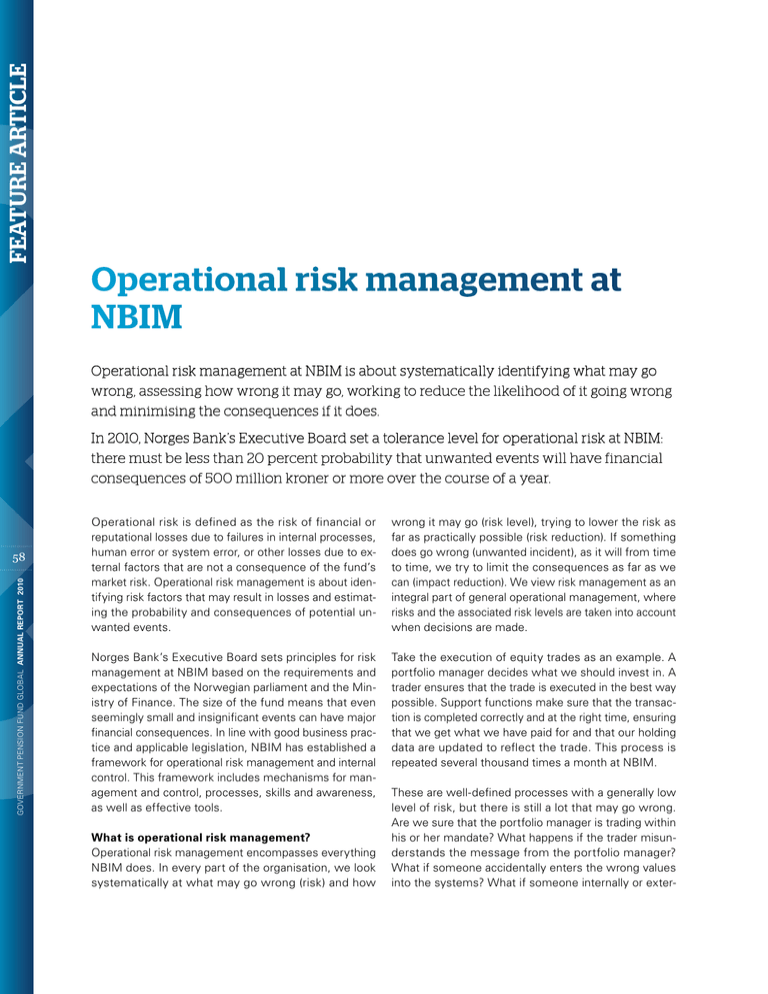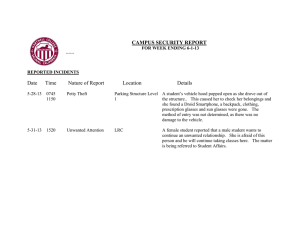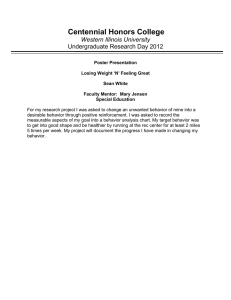Read the article - Norges Bank Investment Management
advertisement

FEATURE ARTICLE Operational risk management at NBIM Operational risk management at NBIM is about systematically identifying what may go wrong, assessing how wrong it may go, working to reduce the likelihood of it going wrong and minimising the consequences if it does. In 2010, Norges Bank’s Executive Board set a tolerance level for operational risk at NBIM: there must be less than 20 percent probability that unwanted events will have financial consequences of 500 million kroner or more over the course of a year. GOVERNMENT PENSION FUND GLOBAL ANNUAL REPORT 2010 58 Operational risk is defined as the risk of financial or reputational losses due to failures in internal processes, human error or system error, or other losses due to external factors that are not a consequence of the fund’s market risk. Operational risk management is about identifying risk factors that may result in losses and estimating the probability and consequences of potential unwanted events. wrong it may go (risk level), trying to lower the risk as far as practically possible (risk reduction). If something does go wrong (unwanted incident), as it will from time to time, we try to limit the consequences as far as we can (impact reduction). We view risk management as an integral part of general operational management, where risks and the associated risk levels are taken into account when decisions are made. Norges Bank’s Executive Board sets principles for risk management at NBIM based on the requirements and expectations of the Norwegian parliament and the Ministry of Finance. The size of the fund means that even seemingly small and insignificant events can have major financial consequences. In line with good business practice and applicable legislation, NBIM has established a framework for operational risk management and internal control. This framework includes mechanisms for management and control, processes, skills and awareness, as well as effective tools. Take the execution of equity trades as an example. A portfolio manager decides what we should invest in. A trader ensures that the trade is executed in the best way possible. Support functions make sure that the transaction is completed correctly and at the right time, ensuring that we get what we have paid for and that our holding data are updated to reflect the trade. This process is repeated several thousand times a month at NBIM. What is operational risk management? Operational risk management encompasses everything NBIM does. In every part of the organisation, we look systematically at what may go wrong (risk) and how These are well-defined processes with a generally low level of risk, but there is still a lot that may go wrong. Are we sure that the portfolio manager is trading within his or her mandate? What happens if the trader misunderstands the message from the portfolio manager? What if someone accidentally enters the wrong values into the systems? What if someone internally or exter- FEATURE ARTICLE nally tries to defraud us? What if the systems fail to work as they should? What kind of internal control do we need in place to ensure that this chain of activities is carried out as robustly as possible? We can never achieve zero risk, so what level is acceptable? The challenge for operational risk management is to answer these and similar questions and to establish a systematic approach to identifying what may go wrong and finding the right countermeasures throughout the organisation. At the same time, risk needs to be considered in light of the cost of risk-reducing measures. The tolerance level set by the Executive Board means that the total financial impact of all unwanted events at NBIM in a normal year should be well below 500 million kroner. This is a gross limit that includes gains and losses. An example of a gain following an unwanted event might be when a portfolio manager buys an equity outside his or her mandate and its price subsequently rises. When the position is reversed, this will result in a gain for the fund. While profitable, this is nonetheless an unwanted event. The total financial consequences of unwanted events are expected to average 200–300 million kroner a year, equal to about 0.01 percent of assets under management at the end of 2010. Identification of risk Our efforts to identify, assess and reduce operational risk is the core of operational risk management and internal control at NBIM. We look at operational risk related to strategies and action plans as well as ongoing processes. Strategies and action plans lead to change that impacts risk levels positively or negatively. We consider our overall goals and identify what may prevent us from achieving these. We also consider how associated measures may affect the existing risk picture. Some plans may have an unacceptable impact on the operational risk picture. At the same time, defined working processes form the basis for ongoing identification and follow-up of risk throughout the organisation. These processes say something about how we work internally across the various departments. They also show how we deal with external suppliers, how we use systems and tools and how the outcomes of one process contribute to another. Based on these processes, we attempt to systematically identify risk factors – that is, individual, unwanted events that may occur. Assessment of risk level For each of the unwanted events identified, we first estimate the level of risk before internal control measures are implemented (inherent risk level). In equity management, inherent risk varies between the markets we invest in, partly because some marketplaces are better regulated and more mature than others. Inherent risk also varies between asset classes. It is higher for real estate investments than for equity investments from an operational standpoint, because the processes are more manual and susceptible to human error. We then look at the risk reduction measures already in place for the various risk factors. These will normally include good processes and control procedures, and together these control measures make up our internal control environment. 59 FEATURE ARTICLE GOVERNMENT PENSION FUND GLOBAL ANNUAL REPORT 2010 60 Finally, we consider the risk level for each individual risk factor once these established control measures are taken into account (current risk level). agers. We consider the risk too high in some markets and cases, choosing instead to keep the mandates inhouse at NBIM. Mitigation of risk If a particular risk factor or the aggregated current risk level falls outside the Executive Board’s risk tolerance level, further action needs to be taken to mitigate the risk. This can be done either by reducing the probability of a potential unwanted event or by reducing the consequences if it does occur. In general, we could say that we aim to lower risk as far as practically possible. This normally involves an assessment of costs versus benefits. We would not want the cost of reducing a risk to exceed the potential loss unless other factors are more important, such as possible reputational consequences. Following up and reporting on events Risk management and internal control at NBIM build on three lines of defence. The first is the operational units themselves, which own the risks, events and actions. The second is the compliance department, which ensures that the first line carries out processes and control procedures within set governing structures and boundaries. The third is Norges Bank’s internal audit unit, which continuously evaluates risk management and control procedures in the first two lines. An example of a probability reducing measure may be to build error detection into trading systems so that data entry errors are blocked before anything goes wrong. If events are of a type where their probability cannot be reduced, such as natural disasters, risk mitigation will primarily take the form of contingency plans. Other times, an unacceptable level of risk might mean that we decide against a particular course of action. This may occur when deciding whether to use external man- However good our internal controls, and however many risk reduction measures we introduce, unforeseen events will occur from time to time. NBIM reports and follows up such events on a continuous basis, both those that actually occur and ”near misses.” These include both internal and external events with potential financial or reputational consequences for NBIM. All such events are followed up and investigations are immediately initiated if the events are serious. We estimate the actual loss from each individual event and compare the total losses from all events with the Executive Board’s risk tolerance level. FEATURE ARTICLE Reporting to the Executive Board Operational risk and events are reported regularly as part of NBIM’s internal management reporting. In addition, a report on operational risk and internal control is submitted to the Executive Board each quarter. This report covers events that have occurred, an assessment of the status of internal control in the organisation and a risk outlook with planned risk-reducing measures. NBIM also estimates and reports expected losses for the various risk factors. Attitudes and culture The attitudes and approach of NBIM’s employees are crucial for good operational risk management. NBIM aims to build a culture which promotes awareness of operational risk. This is a culture where all errors are reported, where errors are tolerated but where we try to learn from them. We aim for the highest possible level of openness, both internally and externally. We want a culture where the individual employee can notify his or her superior of a suspected problem and be taken seriously, and where we strive continuously to improve working processes with an awareness of the associated operational risks. 61



